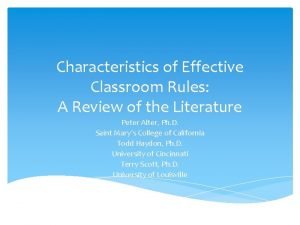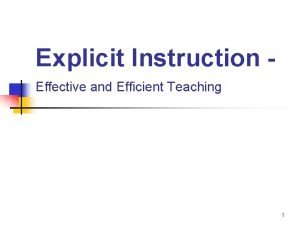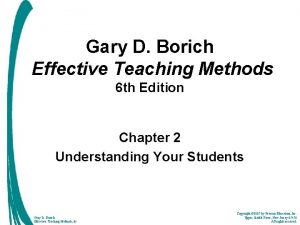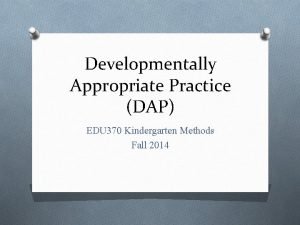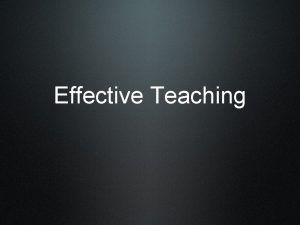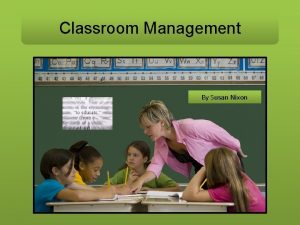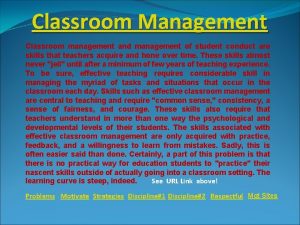A View of Some Effective Classroom Management Teaching













- Slides: 13

A View of Some Effective Classroom Management, Teaching, and Discipline Strategies Classroom Management Strategies Discipline Strategies: Schoolwide Positive Behavioral Supports Proactive and Reactive Discipline Consistency Management & Cooperative Discipline (CMCD) Affective Teaching Strategies Learning Strategies: Inquiry-Based Learning

Classroom Management Strategies �The key to classroom management is building a nurturing community through community-building exercises and a set of expectations that students have helped to develop. (Wolfgang, 2009) �Classroom management not only involves organizing the physical environment, but also curriculum and instruction to create an environment conducive for learning. (Poon, Tan, & Tan, 2009) �Structured and varied grouping is important to classroom management and maintains the standard of valuing collaboration and cooperation. (Wolfgang, 2009)

Classroom Management Strategies �It must be developed throughout the year with specific focus on the first days of school. (Wolfgang, 2009) �Effective classroom management involves the design and implementation of efficient routines, policies, and procedures for participating in class discussion, forming cooperative learning groups, accomplishing seatwork, collecting assignments, turning in late work, and leaving the room. (Sterling, 2009) �Classroom management is a broad term which incorporates every aspect of teaching strategies, but is often overlooked by many. It incorporates active learning processes, teamwork, and discipline issues.

Discipline Strategies Schoolwide Positive Behavioral Supports (SPBS) �It’s a three-tiered framework for implementing schoolwide practices and systems aimed at preventing behavioral problems. (Sugai, 2009) �In the first tier of SPBS, all students should be exposed to a formal, positive, preventive social-skills curriculum that supports the academic mission of the school. (Sugai, 2009) �At the second tier, students receive extra, more intensified help, often in small groups. (Sugai, 2009) �At the third tier, we typically see high levels of adult contact and monitoring. (Sugai, 2009)

Discipline Strategies Schoolwide Positive Behavioral Supports (SPBS) �Behaviors such as conflict management, bullying prevention, teaching respect, or cooperative learning are taught across all three tiers. (Sugai, 2009) �Students also need to receive feedback on their behavior, including recognition, acknowledgment, and positive reinforcement. (Sugai, 2009)

Discipline Strategies Proactive and Reactive Discipline Strategies �Proactive discipline plans can be conceptualized as being preventative and taking a positive approach to classroom management. (Clunies-Ross, Little, & Keinhuis, 2008) �Teachers using Reactive strategies are more likely to respond negatively to students’ inappropriate behaviors, rather than responding positively to students’ appropriate behaviors. (Clunies-Ross, Little, & Keinhuis, 2008) �If you need to correct individuals or groups, make sure to do so during an active time when everyone else is engaged so that attention is not drawn to those students. (Wolfgang, 2009)

Discipline Strategies Consistency Management & Cooperative Discipline (CMCD) �It’s an instructional and classroom management program that emphasizes preventing discipline problems before they begin, improving school and classroom climate as well as student behavior, and effectively managing instructional time, resulting in greater student achievement. (Freiberg, Huzinec, Templeton, 2009) �It creates a person-centered, caring, disciplined, and respectful climate in classrooms, while reinforcing an environment focused on active learning. (Freiberg, Huzinec, Templeton, 2009)

Affective Teaching Strategies Affective Teachers �Effective teachers are prepared; they plan the classroom environment, set up the materials, are ready to teach before class starts, and continually analyze how to make their teaching more productive. (Sterling, 2009) �The teaching process should take into account individual differences in cognitive, emotional and motivational student functioning, on the one hand, and learning should actively engage the learner and be relevant to personal interests, experiences and needs, on the other. (Shechtman & Leichtentritt, 2009) �Teachers must establish routines to facilitate classroom procedures, which is key to successful teaching and learning. (Sterling, 2009)

Affective Teaching Strategies Affective Teachers �By being an authentic, affective teacher, learners are involved, they believe that teachers are interested personally in them, learning is connected to the real world and their personal interests, pupils may not only become effective learners, but also enhance their social skills. (Shechtman & Leichtentritt, 2009) �Instruction includes both the teacher providing directions and information, and students working together. (Sterling, 2009) �In affective lessons, children expressed themselves more frequently, cognitively and emotionally, and expressed some understanding and insight. (Shechtman & Leichtentritt, 2009)

Learning Strategies Inquiry-Based Learning �It involves very active and often more student-centered activities where students interact more intensively with materials and with other students during investigations. (Poon, Tan, & Tan, 2009) �It focuses on real-life instruction and task performance guidelines while also allowing for creative interpretations made by students. �The relevance and appeal of tasks and activities chosen and how they are organized for teaching and learning can have an impact on student behavior in the classroom. (Poon, Tan, & Tan, 2009)

Learning Strategies Inquiry-Based Learning �Because students want to learn through collaborative investigative activities, they regulate their own behaviors and sometimes censor group members who threaten to disrupt their activities with off-task behaviors. (Poon, Tan, & Tan, 2009) �Students’ reflection on their own learning processes helps build shared values in the classroom and motivates students. (Poon, Tan, & Tan, 2009) �Tasks must be designed to be achievable. (Brophy, 1987)

References � Brophy, J. (1987). Synthesis of research on strategies for motivating students to learn. Educational Leadership, 45(2) p 40– 48 Oct. 1987. 8 pp. Retrieved on March 20, 2010 from http: //www. ascd. org/ASCD/pdf/journals/ed_lead/el_198710_brophy. pdf � Clunies-Ross, P. , Little, E. , & Kienhuis, M. (2008). Self-reported and actual use of proactive and reactive classroom management strategies and their relationship with teacher stress and student behaviour. Educational Psychology, 28(6) p 693 -710 Oct. 2008. 17 pp. Retrieved on March 20, 2010 from ERIC database (EJ 809773) � Freiberg, H. J. , Huzinec, C. A. , Templeton, S. M. (2009). Classroom management--A pathway to student achievement: A study of fourteen inner-city elementary schools. Elementary School Journal, 110(1) 63 -80. Sept. 2009. 18 pp. Retrieved on February 15, 2009 from ERIC database (EJ 851763) � Poon, C. , Tan, D. , & Tan, A. (2009). Classroom management an inquiry-based learning: Finding the balance. Science Scope, 32(9) p 18 -21 Jul. 2009. 4 pp. Retrieved on March 7, 2010 from ERIC database (EJ 850038) � Shechtman, Z. & Leichtentritt, J. (2004). Affective teaching: A method to enhance classroom management. European Journal of Teacher Education, 27(3) p 323 -333 Oct. 2004. 10 pp. Retrieved on March 5, 2010 from ERIC database (EJ 719144) � Sterling, D. R. (2009). Classroom management: Setting up the classroom for learning. Science Scope, 32(9) 29 -33. Jul. 2009. 5 pp. Retrieved on February 15, 2009 from ERIC database (EJ 850040) � Sugai, G. (2009). Beyond the discipline handbook: How schools can implement a positive approach to managing student behavior. Education Digest: Essential Readings Condensed for Quick Review, 75(3) 37 -41. Nov. 2009. 5 pp. Retrieved on February 15, 2009 from ERIC database (EJ 863913) � Wolfgang, C. N. (2009). Managing inquiry-based classrooms. Science Scope, 32(9) p 14 -17 Jul. 2009. 4 pp. Retrieved on March 5, 2010 from ERIC database (EJ 850037)

 Elements of effective classroom management
Elements of effective classroom management Sourima mal
Sourima mal Characteristics of effective classroom rules
Characteristics of effective classroom rules Teaching and assessing grammar in the writing classroom
Teaching and assessing grammar in the writing classroom Te kotahitanga effective teaching profile
Te kotahitanga effective teaching profile Examples of explicit instruction
Examples of explicit instruction Borich effective teaching methods
Borich effective teaching methods 10 principles of effective online teaching
10 principles of effective online teaching Measures of effective teaching project
Measures of effective teaching project Developmentally appropriate practice for kindergarten
Developmentally appropriate practice for kindergarten Effective teaching evidence and practice
Effective teaching evidence and practice They say sometimes you win some
They say sometimes you win some God when you choose to leave mountains unmovable
God when you choose to leave mountains unmovable Ice cream is countable
Ice cream is countable


